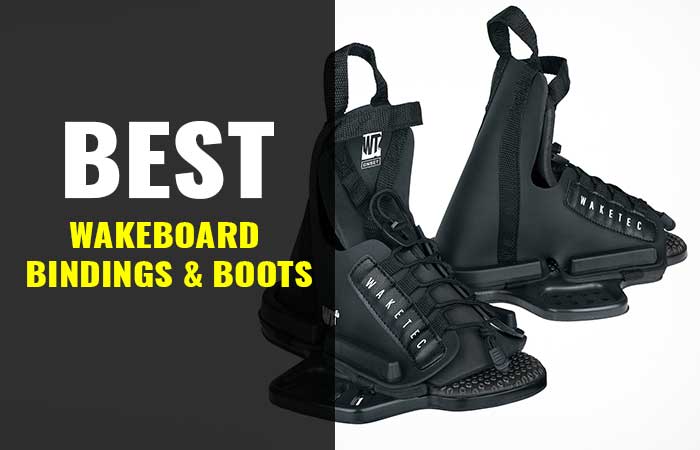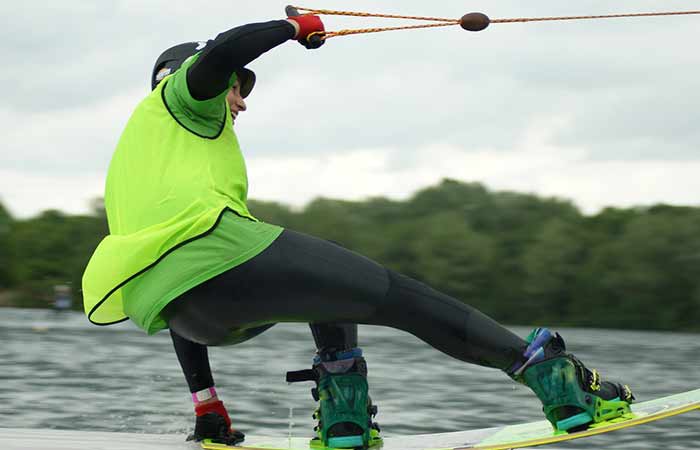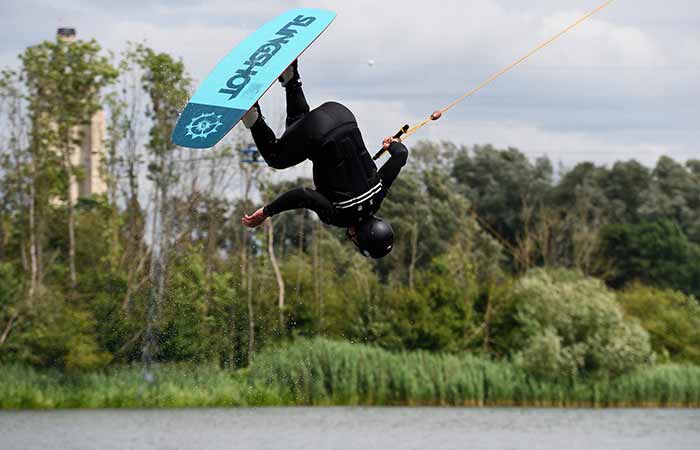How to Pick the Right Wakeboard Size-Chart & Guide
The right size of wakeboard has many advantages the most important of which is the control you have over the water. You have to choose a board based on your height and weight for the best results. Otherwise, you may have all the skills you need yet find it hard putting the board under control owing to the mismatch in size between the board and your body.
Below, we assess the importance of the weight and height on the size of the board you choose. Beyond that, we assess the skill level and other aspects that contribute to the size of wakeboard to pick. Keep in mind that it’s not a straight answer as to the size of the board you get since the shape is also a factor.
Wakeboard Sizing Chart
| Rider Weight in LBS | Wakeboard Length in CM |
| Up to 85 lbs | 119 cm |
| Up to 105 lbs | 121 cm |
| Up to 130 lbs | 130-131 cm |
| Up to 160 lbs | 132-133 cm |
| Up to 180 lbs | 134-135 cm |
| Up to 200 lbs | 136-139 cm |
| Over 200 lbs | 140 cm and above |
The chart above is often the standard for those buying a wakeboard. As seen here, the size of the board is matched with the weight of the rider with the readings often available on the product label or the website of the manufacturer.
Factors to Consider in Choosing the Type and Size of Wakeboard
Some of the aspects to help you make the right choice when it comes to the size of the board include the following:
The weight of the rider
Generally, the weight of the rider goes hand in hand with the size of the wakeboard. As such, the heavier you weigh, the larger the wakeboard you will need. A longer board has a higher buoyancy and will thus support your weight better than a shorter one.
The height of the rider
Just like the weight, the height of the rider will also dictate how large a boar they get. The taller you are, the longer the wakeboard you’ll need to keep a balance. In most cases, taller people also weigh more.
However, there are cases where taller people weight less than their shorter counterparts. As such, the weight should always take precedence over the height of the rider. If more than one rider will use the board, you’re better off using the height and weight of the tallest and heaviest rider for the board.
Weight of the wakeboard
The lighter a wakeboard is, the faster it will be on the water. This is because it’ll have a higher level of buoyancy and be easier to control. However, it can be tough handling such a light board if you’re new to wakeboarding. The weight of the wakeboard will be determined by different factors among them the materials used and the size of the board.
In general, decreasing the size of a board makes it lighter, more aggressive and it’ll spin faster. Landing also gets difficult with a smaller board as there will be less surface area of the board in contact with the water. If you’re a pro, however, smaller boards are better as they offer better maneuverability compared to larger ones. you can do better tricks on smaller boards.
The rider’s skill level
There are three classes of skill levels when it comes to wakeboarding namely the beginner, intermediate and the expert.

While a beginner can also use a wakeboard created for the expert, they’ll have a hard time keeping in control and it’s always wise to start with the beginner’s board for the best learning experience. Once you learn the basics, you can then advance through the ranks to the expert level with different boards.
Wakeboard materials and base shapes
Some common wakeboard base shapes and materials include the following:
Concaves
Concaves are special dents on the bottom of the board that add lift to the it while also acting as suction-reducing accelerators. Their effect is that the board will sit higher in the water and cruises much easily.
V-shape spines
Common to the 3-stage rocker wakeboards, V-shape spines soften your landings while allowing you to roll to either edge easily. Looking at their effect, thy act like the v hull shapes found in some boats reliant on wind for propulsion.
Base material
The base material of your wakeboard is important since it determines how effective the board will be when used with sliders.
Channels
Channels help to break the surface tension of the water before the rest of the board settles on the surface. They’re similar to fins on the bottom of the board.
Featureless
A featureless wakeboard is one without any channels or molded-in fins. Such a wakeboard’s performance will solely rely on its shape and the rocker.
Grind base
Thanks to increase in the popularity of rail riding, grind bases were developed with a tough base for the board. Such a board has a very tough base able to withstand the wear and tear from gliding over rocks, metal or PVC surfaces.
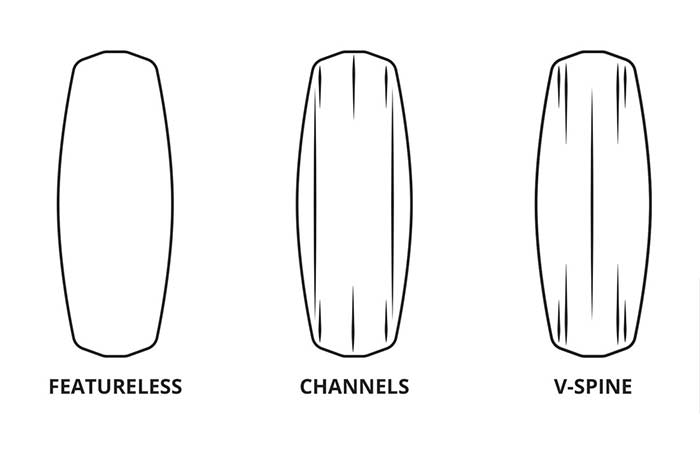
The wakeboard rocker and riding style
There are different types of wakeboard rockers and riding styles including the following:
Continuous rocker wakeboards
A wakeboard with a continuous rocker has one continuous curved shape from the tip to the tail. Such wakeboards are the best for a fast and smooth ride. They also allow for an easy linking of turns when you’re on the water.
One of the most outstanding features of the continuous rocker wakeboard is that it can generate lots of speed on the water. When you hit the wake in this type of board, you get a very predictable pop (height) and will shoot you farther out into the flats as well. These boards are also very good when it comes to carving.
3-Stage rocker wakeboards
A 3-stage rocker wakeboard has three independent planes for the tip, tail and the middle section rather than one smooth rocker like the previous board.
This makes it respond with a bigger pop (height) each time you hit the wake. This isn’t always a good thing as it means the board will be more slippery on the surface of the water. The board is also slower since the board plows rather than cutting through the water.
The fins of your board also have a reduced effectiveness. As such, you must rely more on edging the wakeboard. Generally, these boards have a slightly sluggish feel to their landings.
Hybrid rocker wakeboards
The hybrid rocker wakeboard combines the best bits of the continuous rocker and 3-stage wakeboards for a great feel and control of the board in different conditions.
For this reason, it’s given different names including abrupt continuous, hybrid 3-stage, hybrid rocker and blended 3-stage wakeboard. It’s all about knowing what works best for you then picking it.
Camber wakeboards
The camber wakeboards are a very different take to the wakeboard compared to the continuous and 3-stage boards. Rather than curving upwards at the tail and tip, it slightly curves downwards. This shape changes the weight distribution immensely with great results once you get a hang of it. They get their inspiration from snowboards and skis.
Wake board fins
The fins of your board play important roles as they grip the water and determine your motions and how easy they will be on the water. The aspects affecting fins and how to choose the right ones include the following:
Fin size and placement
If you get longer or deeper fins for your wakeboard, the board will have a more stable ride but a reduced capability to perform tricks. These are the best conditions for beginners to grasp the basics of wakeboarding and other water sports in general as they offer less chances for mistakes.
With time and practice, you’ll slowly reduce the number and size of the fins until you can have none of them for performing the very complex tricks on a wakeboard. If you’re still using fins, you’re better off placing them at the for the best experience on the water.
Molded-in or removable wakeboard fins
Molded-in fins can’t come off while the removable ones can be screwed on and off the wakeboard with ease. Some wakeboards have removable fins towards the center of the board and molded-in ones towards the edge of the board. This way, you can vary the feel of your wakeboard by changing the number of fins on the underside.
The wakeboard edges
The edges of the wakeboard are also important when it comes to how the board responds to the waves and the rider. The important aspects about this include these:
The sharpness of the edge
Sharp wakeboard edges make the board very aggressive with higher speeds and acceleration. With a sharp edge, however, you can easily catch an edge and get a fly swatter-like effect on your face. Generally, a sharper edge is harder to control than a rounded one.
If you’re a rider who enjoys surface tricks and riding sliders, you’re better off with a rounder edge on your wakeboard. If you’re the type who like an aggressive board, go for a sharper edge on your board.
Board with variable edges
For a good blend of what you find in boards either with sharp or rounded edges, a board with variable edges will do the trick. Such boards have a different level of sharpness in the middle of the board compared to the tip and the tail.
Generally, they’re thicker and rounder in the middle but become sharper and thinner towards the tail and the tip.
This variation in the sharpness of the edges gives you a high level of grip/tracking when edging. You also get a soft edge for most surface tricks such as butter slides.
The varying edges create a pop and lift towards the center of the board while the thinner edges increase the speed of the board and makes it easier for carving.
With these factors in mind, you will be in a position to not only choose the right size of the wakeboard but one with the right features.
Further Reading on Wakebording
- How to Wakeboard: A Basic Beginner Guide +Tips
- How to Jump on a Wakeboard
- How to Get Up on a Wakeboard
- Wakeboard Tricks & Names: Easiest to the Hardest
- Wakeboarding vs Wake Surfing
- 7 Best Wakeboards + Buy Guide
- Best Wakeboard Life Jackets & Vests for Women, Men & Kids
- Best Wakeboard Bindings & Boots
- 7 Best Wakeboard Towers-What to look for when Buying

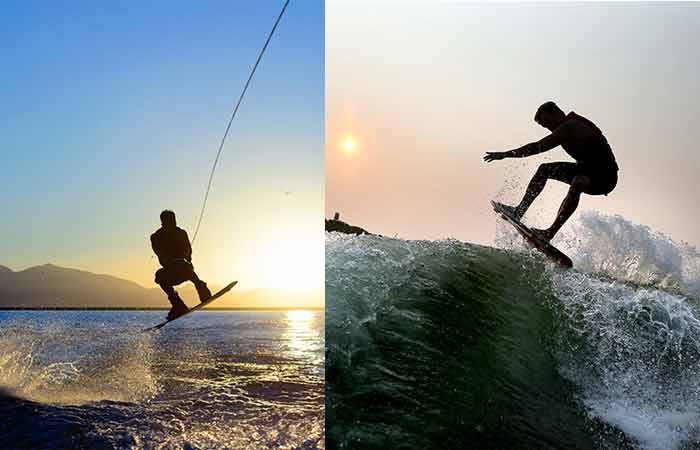
![7 Best Wakeboards + Buy Guide [2021]](https://aquaticglee.com/wp-content/uploads/2021/01/best-wakeboards.jpg)
